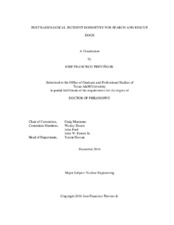| dc.contributor.advisor | Marianno, Craig M | |
| dc.creator | Trevino, Jr., Jose Francisco | |
| dc.date.accessioned | 2017-03-02T16:45:04Z | |
| dc.date.available | 2018-12-01T07:21:18Z | |
| dc.date.created | 2016-12 | |
| dc.date.issued | 2016-10-25 | |
| dc.date.submitted | December 2016 | |
| dc.identifier.uri | https://hdl.handle.net/1969.1/158960 | |
| dc.description.abstract | Urban Search and Rescue (USAR) dogs are valuable members of the USAR teams and are deployed in all types of scenarios and conditions. There is a large investment made with each animal in the form of time and money spent on training. In addition, the handlers are often their owners adding a substantial emotional investment. The inability of USAR dogs to wear any protective equipment for safety reasons leaves them especially vulnerable to any contaminants with which they may come in contact. Interestingly, no research has previously been conducted on the radiation doses received by USAR dogs in a scenario with a contaminated environment. This research aims to give USAR handlers more information when deployed to areas contaminated with radiological material. This dissertation describes the computation of external and internal dose rate conversion factors along with calculations of internal dose rate conversion factors and their compilation into a tool for USAR dog handlers called FidoFRMAC. Decay schema for 48 radionuclides of interest were analyzed and the resulting information was used to calculate external dose rate conversion factors using modified equations originally derived for humans. Calculation of the internal dose rate conversion factors used the Federal Radiological Monitoring and Assessment Center (FRMAC) resuspension dose rate conversion factors as a baseline and scaled breathing parameters to adjust for the differences in respiratory systems of the two species. These dose rate conversion factors were assembled into a spreadsheet program with the ability to import data from atmospheric dispersion models such as QUIC and HOTSPOT. The user can select from the radionuclides of interest and obtain visual representations of the dose rates resulting from the contamination. It is the hope that this research and resulting program will be of use to USAR handlers and will play a small part in keeping these animals safe. | en |
| dc.format.mimetype | application/pdf | |
| dc.language.iso | en | |
| dc.subject | search and rescue | en |
| dc.subject | canines | en |
| dc.subject | radiological | en |
| dc.subject | dosimetry | en |
| dc.title | Post Radiological Incident Dosimetry for Search and Rescue Dogs | en |
| dc.type | Thesis | en |
| thesis.degree.department | Nuclear Engineering | en |
| thesis.degree.discipline | Nuclear Engineering | en |
| thesis.degree.grantor | Texas A & M University | en |
| thesis.degree.name | Doctor of Philosophy | en |
| thesis.degree.level | Doctoral | en |
| dc.contributor.committeeMember | Poston, John W. | |
| dc.contributor.committeeMember | Ford, John | |
| dc.contributor.committeeMember | Bissett, Wesley | |
| dc.type.material | text | en |
| dc.date.updated | 2017-03-02T16:45:04Z | |
| local.embargo.terms | 2018-12-01 | |
| local.etdauthor.orcid | 0000-0002-5488-7714 | |


